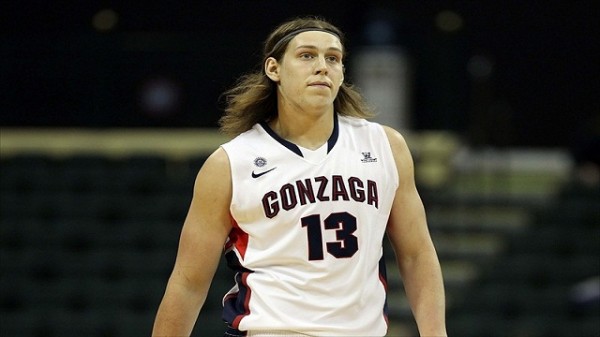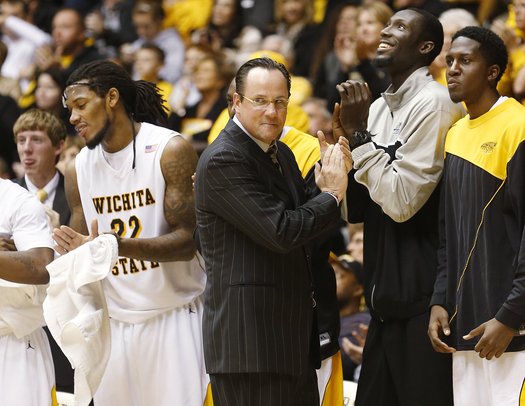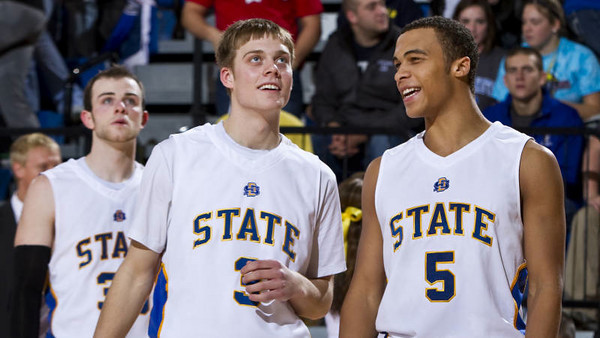The Other 26: Bracket-Busting, South and West Edition
Posted by IRenko on March 19th, 2013I. Renko is an RTC columnist and the author of the weekly column, The Other 26. Follow him on Twitter @IRenkoHoops.
Oh, well. What’s a royal ball? After all, I suppose it would be frightfully dull, and-and-and boring, and-and completely… Completely wonderful. — Cinderella
It’s time for college basketball’s annual ball, which means it’s time for America to fall in love with Cinderella all over again. There are 36 teams from the 26 non-power-conferences who have been invited to this year’s Big Dance, and while the slipper no longer fits for some of the more prominent of these schools, for the bulk of them, this is a rare opportunity to make a name for themselves on the grandest of stages.
This is the first of a two-part series taking a look at the NCAA Tournament prospects for all 36 teams hailing from The Other 26. We focus today on the TO26 teams in the South and West regions, grouping them into five rough categories, and, within each category, ordering them by their likelihood of advancing.
Regional Threats
These are the teams that have a credible chance of dancing all the way to the Sweet Sixteen and beyond.
- Gonzaga (#1, West) — It’s been five years since a TO26 team reached the top seed line. In 2008, Memphis rode its #1 seed all the way to the brink of a national championship, and Zags fans are hoping for the same — and perhaps more — this year. Gonzaga has no glaring weaknesses. They are led by an athletic, skilled frontcourt, the centerpiece of which is NPOY candidate Kelly Olynyk. They get steady guard play from Kevin Pangos, Gary Bell, and David Stockton. If they’re to run into any trouble, it will likely be against a team that (1) sports a strong, athletic interior defense that can contain Olynyk, Elias Harris, and Sam Dower and pound the glass, and (2) can hit the three-point shot consistently, as Illinois did in beating them (Gonzaga’s defense allows a lot of three-point attempts). There are a fair number of teams that meet the first criteria in the West bracket, but not many with a lot offensive firepower from the three-point line or otherwise. In short, this is as good a shot as Gonzaga has ever had to make the Final Four. The eyes of the nation will be watching to see if they can make good on their promise.
- Virginia Commonwealth (#5, South) — VCU is a popular sleeper pick for the Final Four, and there’s some merit to that notion, but here is the most important thing you need to know about them: They are 25-2 on the year (and 14-0 in A-10 play) against teams with a turnover rate over 18 percent. And they are 1-6 (and 0-5 in A-10 play) against teams with a turnover rate under 18 percent. The Rams’ first-round opponent, Akron, falls squarely in the former camp (20.8 percent), a problem for the Zips that will be exacerbated by the absence of their legally-troubled starting point guard, Alex Abreu. After that, things get a bit trickier for the Rams. Their two potential Third Round opponents, Michigan and South Dakota State, rank in the top 10 in the country in turnover rate. Those stats are perhaps somewhat inflated by the fact that both teams play in conferences that don’t feature a lot of pressure defenses, but if you’re looking for a point guard to lead you against such a defense, you’d be hard-pressed to find a better option than Trey Burke or Nate Wolters. It’s true that Michigan has struggled lately in general, and that if you look ahead to a potential match-up with Kansas in the Sweet Sixteen, Havoc’s odds of success improve, but I’d caution against over-exuberance at the Rams’ chances given a potentially dicey Third Round contest.
- New Mexico (#3, West) — The Lobos have had a great year, and they may well get to the Sweet Sixteen. They feature a stout, compact defense that makes it tough for teams to get into the paint and score. But they are prone to stretches of offensive stagnation, and lead scorers Kendall Williams and Tony Snell can be streaky. They rely heavily on getting to the free throw line, which can be a dicey proposition in NCAA Tournament play. A Sweet Sixteen match-up against Ohio State and its tough defense isn’t going to make scoring especially easy. In addition, the Lobos’ defense, while generally quite strong, is vulnerable to the three-point shot, and there are a couple of teams in their pod (Harvard, Belmont) who have the shooters to exploit that weakness. There’s Final Four potential here, but at the end of the day, it will take a level of offensive consistency that the Lobos have struggled to find this season.
- Belmont (#11, West) — I keep notes on many of the teams that I watch during a season, and here’s what I had jotted down about Belmont as of the night they clinched their auto bid: “If they play a team that can take care of the ball and defend the three, could be a problem for them. But if they play a team that turns it over and doesn’t guard the three well, Belmont may have a chance.” Well, on the surface, they have a chance, as turnover rate and three-point FG percentage defense are two of Arizona’s worst statistical metrics. Although the Wildcats have improved their ball control over the course of the season, five of their Pac-12 losses came to the teams ranked in the top three in forcing turnovers and in steals: Oregon, UCLA, and Colorado. In all but one of those games, Arizona’s turnover rate exceeded 20 percent. But while the Wildcats allow opponents to make a relatively high three-point FG percentage, they don’t allow opponents to take many threes, and Arizona also has a serious advantage inside with freshmen Kaleb Tarczewski and Brandon Ashley matching up with the 6’7″ Blake Jenkins and 6’6″ Trevor Noack. It’s a tough call, but there is some intangible aspect of this match-up — perhaps Arizona’s relative youth or the way that they slid to a #6 seed from an early top five ranking; perhaps Belmont’s relative experience and their status as a mid-major standard-bearer — that pulls me in the direction of a Belmont call. A second game, likely against New Mexico, is also tough to predict. On the one hand, the Lobos do a great job of taking care of the ball, but on the other end, they’re very susceptible to the three-point shot. At the end of the day, it’ll be a tough road, but the Bruins are a viable Sweet Sixteen team.
One and Done
These teams have at least a 50/50 (or better) chance of picking up a win, but are unlikely to get two.
- Wichita State (#9, West) — The Shockers are one of the toughest, most physical teams in the country. But they need all the grit they can muster to compensate for all the offense they can’t. Scoring doesn’t come easy for Gregg Marshall’s unit, but their defense and rebounding have carried them to a 26-8 record and a well-deserved #9 seed. A first-round match-up with Pitt is likely to be a slugfest under the basket. Wichita State is as focused on keeping teams from scoring in the paint as Pitt is focused on scoring in the paint. And the same is true, more or less, at the other end of the court. This game could be a low-scoring battle that is won by whichever team is able to hit a few key jumpers. The Shockers’ Ron Baker, recently returned from injury, could be the difference-maker in that regard. A second-round game against Gonzaga might actually be a doable feet for this team, but it’s betting a lot to expect them to find the offense to conquer two strong teams in a row.
- San Diego State (#7, South) — I give the Aztecs decent odds against a relatively mediocre Oklahoma team with no NCAA Tournament experience, but I wouldn’t bank on them getting much further than that. The Aztecs were solid at home, but failed to secure a notable road victory. It’s hard to expect them to travel all the way across the country and beat a Georgetown team playing a few hours’ drive from campus. That’s especially true given the Hoyas’ ability to contain the kind of dribble penetration that is instrumental to the Aztecs’ offensive success.
- La Salle (#13, West) / Boise State (#13, West) — These two teams should give us an evenly-matched, entertaining play-in game on Wednesday night. Both are guard-oriented squads that take care of the ball and rely on the three-point shot for more than 30 percent of their points. I give the edge to La Salle, because their defense tends to take away the three, whereas Boise’s tends to allow it, and if their shots aren’t falling, the Explorers’ guards are more likely to score off the bounce. But this might just come down to whichever team gets the hot hand. The winner would have a shot at toppling against Kansas State, one of the weaker #4 seeds in the field. But I suspect the Wildcats’ offensive rebounding might overwhelm La Salle, while the combination Angel Rodriguez’ dribble penetration and the KSU’s outside shooting could undo Boise.
The Slipper May Fit
These are the low seeds that have a solid chance of scoring a big Second Round upset.
- South Dakota State (#13, South) — The Nate Wolters Show is coming to prime time. The match-up between Wolters and Michigan’s Trey Burke, and the Jackrabbits’ genuine upset potential, makes this an appetizing #4/#13 game. Michigan’s offense is far better than its defense, so while I expect them to have a relatively easy time putting points on the board against a mediocre South Dakota State defense, don’t be surprised if Wolters and the cadre of shooters that ride shotgun find the net with regularity. Wolters is not only a great scorer in his own right, equally adept at shooting the three and attacking the basket, but he’s a tremendous facilitator (5.8 assists per game to go with his 22.7 PPG). I wouldn’t peg the Jackrabbits’ odds at greater than 50/50, but there is nothing so valuable in March as a star who can take over a game. Wolters is that guy. A Michigan team that has struggled a bit down the stretch may be vulnerable to his heroics.
- Harvard (#14, West) — Harvard should be pleased, relatively speaking, with a #14 seed and a draw with New Mexico. The Lobos are strongly favored for good reason, but the Crimson have the shooters (Siyani Chambers, Laurent Rivard, and Christian Webster) to exploit New Mexico’s compact defense, which is generally stingy but allows a high volume of three-point scoring. The Lobos’ tendency to pack it in also gives the Crimson’s tendency to turn it over a bit of a reprieve. And the interior combination of Alex Kirk, Chad Adams, and Cameron Bairstow is not as unmanageable for Harvard’s front line as a lot of other #2 or #3 seed frontcourts would have been. I think this game has clear upset potential.
A Puncher’s Chance
These teams have an outside shot of winning their second round game — if lots of things break their way.
- Akron (#12, South) — Congratulations to Carmelo Betancourt, the backup point guard who was steady enough in the wake of Alex Abreu’s arrest to get the Zips through the MAC Tournament and into the Big Dance. His reward? The Havoc Defense. The 5’11” freshman has a high turnover rate, and Akron does not have other capable ball-handlers on whom they can rely to break VCU’s pressure. This is a recipe for a very long night. Ideally, the Zips would like to set up the halfcourt defense and pound it inside to seven-footer Zeke Marshall and stocky power forward Demetrius Treadwell. But good luck finding the rhythm to do that against the Rams. VCU is a weak rebounding team, and the Zips can pound the offensive glass, but that disparity hasn’t stopped the Rams this year — they beat the top five offensive rebounding teams in the A-10 by an average of 13.2 PPG. Akron’s one saving grace may be on the other end of the court, where their tough interior defense, led by Marshall’s shot-blocking presence, could make things tough inside for VCU’s dribble-drive attack, and if the Rams’ streaky shooters can’t find the mark, it could be tough for them to score and set their press.
- Florida Gulf Coast (#15, South) — It’s hard to dismiss a team that knocked off Miami, a group that nearly secured a #1 seed. And when you’re a team like Georgetown that can sometimes struggle to score, there’s always the possibility of being upset. In FGCU’s favor is its ability to force turnovers, a surprisingly weak point for the Hoyas. But FGCU’s guards are going to find that Georgetown’s defense is not very welcoming to the kind of penetration on which they rely. Point guard Brett Comer is a great facilitator with the body of a power conference point guard, but he’s going to have a heck of a time figuring out how to attack the Hoyas. Wing guards Sherwood Brown and Bernard Thompson are capable shooters, but the Hoyas’ mix of zone and man defenses can shut down the three-point line (Big East opponents shot 27.9 percent from behind the arc).
- Iona (#15, West) — I think Iona may have deserved a #14 seed, but regardless, a first-round matchup with Ohio State is a tough one for them. The Gaels like to push the tempo, press a bit, and score in transition, where they can be ruthlessly effective. They have an athletic guard corps, led by Arizona transfer Lamont “Momo” Jones, and they do not hesitate to try to create their own shot in the halfcourt defense. But the Buckeyes’ defense, which has been especially strong of late, is not likely to yield. In winning at Indiana, Ohio State showed they could impose their physicality and defensive toughness on a high-octane offense. Moreover, the Gaels are very small inside, putting them at a big disadvantage against a top-tier power conference team, and they really struggle defensively. Deshaun Thomas’ inside-out game will likely be a very tough matchup for them.
- Southern (#16, West) — Maybe I’m just in the mood to troll Gonzaga fans by sticking Southern in this category (rather than the one below), but hear me out. Though Southern struggles to score, they have a couple of shooters, in Derrick Beltran and Malcolm Miller, who can hit the three-point shot, which Gonzaga’s defense tends to allow. The Jaguars take care of the ball and slow the tempo, and defensively they can grind you down and make things difficult. With 6’10” Brandon Moore and 6’8″ Javan Mitchell inside, they don’t suffer the kind of interior size disadvantage that often dooms low-seeded teams.
Enjoy Your Parting Gift
These squads are virtual locks to head home with a nice memory of an NCAA appearance and a Second Round loss.
- Northwestern State (#14, South) — The Demons love to push the pace. They have the fastest tempo in all the land, per KenPom, and they sport a deep 10-man rotation, in which each player averages at least 15 minutes per game. Coach Mike McConathy is known for his hockey-like substitution patterns in which a wholesale lineup change replenishes the Demons’ up-tempo attack. It’s not clear, though, that they’ll get far with this approach against Florida. The Gators take good care of the ball and they have the athletes to outpace Northwestern State in an up and down game or beat them off the dribble in their halfcourt pick-‘n-roll offense.
- Western Kentucky (#16, South) — Expect Western Kentucky to try to chop down Kansas by firing threes over its defense. The only problem is that while the Hilltoppers like to take threes, they’re decidedly “so-so” at making them. At the end of the day, Kansas’ strength around the rim, on both offense and defense, should make Western’s Tournament trip a brief one.













































